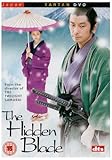Eye For Film >> Movies >> The Hidden Blade (2004) Film Review
If you have seen Twilight Samurai, it helps because this is the sequel, or rather another story from the Edo period (late 19th century) when swords were still considered the only weapons for honourable men ("Firearms are NOT for samurai") and the act of hari-kari the sole method of restoring respect to a disgraced individual.
Social restrictions in Japan were tighter than in England. The class structure could not stretch to include mobility upwards, sideways or any which way. A servant was a servant and a samurai a member of the elite corps. At no meaningful level could the two come together.
Squire Katagiri (Masatoshi Nagase) is a bit of a loner. His father committed hari-kari when the family fortunes took a dive and they had to move to a smaller house in town, to which a 16-year-old girl called Kie (Takako Matsu) travelled from the country to work as his mother's maid. She grew up to be indispensable, wise, generous and kind. Katagiri, many years her senior, always loved her, but could never speak it, for he was a samurai and she a servant.
Co-writer/director Yoji Yamada treats the formalities with more humour than reverence. Even the samurai, excluding Katagiri who remains loyal to the codes of discipline, are depicted as old fashioned and corrupt.
Kie may appear too good to be true and Katagiri a dry stick, but the assortment of supporting characters is a catalogue of delightful eccentricity and the film has been made with love and affection.
As well as repressed emotions and the samurai general's obvious villainy, Yamada explores conflicts of loyalty when Katagiri is ordered to fight to the death with his once best friend, now incarcerated in solitary confinement for attempting to organise a revolt.
Many layered and multi-faceted, The Hidden Blade has secret strengths.
Reviewed on: 10 Jan 2006




















